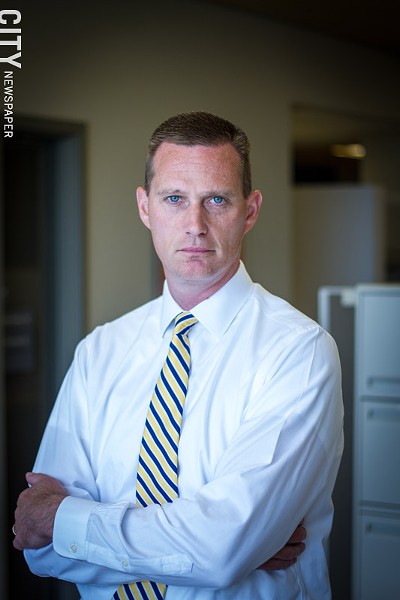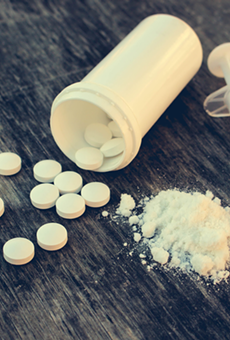At this point, the opioid crisis is inescapable.
Prescription painkiller abuse and the use of increasingly dangerous heroin-fentanyl mixtures is happening across social and economic lines. And the disease of addiction has some people so firmly in its grip that locally they've overdosed in parking lots, libraries, and other public places. Some have even overdosed behind the wheel, causing them to crash into other cars, utility poles, and people's yards.
Stacey Gray, a program nurse at the Villa of Hope, which provides addiction treatment services to youth, presents the situation as a blunt truth: Because the opioid epidemic is widespread, because of stigma and treatment resource shortages, a lot of people are going to see someone overdose, she says.
This is where naloxone, a powerful opioid overdose reversal drug that's saving countless lives, becomes important. It comes in a few forms, but practically any adult can get the nasal spray from a pharmacy without a prescription. The nasal spray kits – which are the simplest to administer – are also increasingly on hand at public places. But the access is good only if people know how to use the kits.
"I believe everyone needs to learn," Gray says.
So Villa of Hope is one of several local government, non-profit, and health agencies that offer public naloxone training. The idea is to make sure that more and more people have at least some familiarity with the drug. That way, if they encounter someone who's overdosed, they're able to help, using their own kits or publicly accessible ones.
Gray led the development of the agency's training program and has organized sessions for her fellow staff members, for other agencies, and for people who know someone struggling with opioid addiction; she trained one group in a person's living room. The free training sessions – which can be very short or can take around an hour – are done by appointment.
Dr. Jeremy Cushman, Monroe County's EMS medical director, says he's responded to overdose calls where a community naloxone kit was available but wasn't used. And overdoses can be traumatic for bystanders, and if they aren't trained on using naloxone, administering it can be very stressful.
For those reasons, Cushman believes naloxone trainings for the public – especially family and friends of people struggling with opioid addiction – are crucial.
People should call 911 when they suspect an overdose, and they should follow dispatchers' instructions, since sometimes the person in crisis may need CPR in addition to naloxone. Still, the availability of naloxone in an emergency can mean the difference between life and death.
"Friends, neighbors, family members, and so forth that have loved ones that are suffering with the disease of addiction – they want to do something, obviously, to help, given the dearth of treatment programs available," Cushman says. "They are empowered to get trained and get this medication, so that if they do witness this in their loved one they can administer it right away."
Naloxone has become an essential tool for local emergency responders, and they've been using a lot of it in recent years. The numbers that agencies have reported to Cushman offer a rough illustration of just how frequently overdoses happen.
Monroe County fire, ambulance, and police staff administered naloxone 657 times from the start of the year through July 1, Cushman says. The numbers are on track to exceed the 748 administrations in 2016 and are well ahead of the 251 administrations in 2012. But the numbers also deserve a few caveats.
Many professionals in the emergency medicine field have used naloxone for decades, though until a few years ago it was typically administered through an IV or an intramuscular injection. EMT's weren't permitted to administer it, which was a problem, since firefighters – many of whom are trained EMT's – are often the first to respond to all kinds of emergencies, including overdoses.
Cushman and a colleague in Albany, Dr. Michael Dailey, got state approval for a pilot project to equip EMT's with a newer version of the drug, a nasal spray. Cushman worked with the Rochester Fire Department initially in 2012. And as the state saw the program's successes, it loosened restrictions on who could administer naloxone at the scene of an overdose.
Now, most emergency responders – right down to the Monroe County Sheriff's Office's police dogs – carry naloxone. The drug can effectively treat dogs that, for example, have accidentally sniffed fentanyl at a crime scene, says John Helfer, public information officer for the sheriff's office.
In short, far more first responders are carrying naloxone out into the field than there were five years ago. And Cushman says the growth shown in the numbers of naloxone administrations results both from the efforts to equip emergency responders with naloxone and from the worsening of the opioid epidemic.
Responders are also up against stronger drugs than they were a few years ago. Painkillers and heroin have been displaced by fentanyl, which is much more potent than heroin and is much more dangerous, Cushman says. Now patients routinely require more than one dose of naloxone to reverse the effects of opioids. In 2015, responders used an average of 1.3 doses, but the number is now closer to 1.5 or 1.6 doses.
"As I tell my responders out there, more often than not you're going to have to give a second dose," he says.
Cushman's guidance to emergency responders shows one reason why it's important for the public to get training. That dosing tip could be very useful in a crisis, and the naloxone nasal spray isn't going to hurt anyone. For the most part, it just gives people wet noses, he says.
But Cushman and Villa of Hope's Gray say that the main focus of naloxone training is hands-on experience with the drug's administration. The drug's nasal sprayer comes in three pieces that have to be assembled at the time of use.
That may sound like a simple enough task, but when a person is watching a family member or friend overdose, they are under a lot of stress. The first time to try assembling a naloxone unit is not when your loved one isn't breathing, Cushman says. Medical officials offer similar guidance for the epinephrine injectors used to treat severe allergic reactions.
"I can't tell you how many times I've administered epinephrine or naloxone in my career, but I'm pretty confident if I had to do it to either of my sons, I would probably be all thumbs," Cushman says.
As with a severe allergic reaction or a heart attack, time matters for overdoses. If people have naloxone on hand and can use it – whether it's bystanders with kits in their vehicles or a family with the drug in its medicine cabinet – they may very well save lives. Familiarity makes people more likely to step up in a crisis, Cushman and Gray say.
"I would just implore folks to make sure they get some hands-on training and some familiarity with it, that they are actually able to assemble it and so forth, so that if they ever actually have to do it they are at least a little bit more familiar and comfortable," Cushman says.

